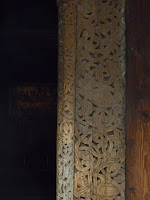 |
| The inside of our ferry in Oslo. |
As we begin our second day in Norway, we are beginning to appreciate the prices back home. A hamburger for $28.00 is a common find and those are at the TGIF Friday's so we know what you get and can compare it to the price back home. We are thankful we had the forethought to pack snacks before leaving home. There is just something wrong with paying that much for a meal. The cost of transportation is high as well with one hour fares within zone one costing about $7. We soon found the multi ticket of 6 rides comes out cheaper. Since we must travel each day, we have been walking alot to shed any extra weight from an ice cream cone or two.
To the left you can see what the inside of the ferry looks like that we take each day to get back and forth from our hostesses house.
Today we wanted a little culture so we visited the Munch Museum. For those who participated in our Fine Art unit, you may remember his most famous painting, The Scream.
We also walked through the Botanical Gardens where we saw many different varieties of plants from all over the world. We saw several tropical plants such as bromeliads that we will be learning about in our Ecosystems unit next year.
The Nobel Peace Center was also one of our stops where we saw a beautiful lighted tribute to the winners through the years.
 |
| Paraffin burns here to heat the home |
 |
| Parafffin is used to heat many homes |
At the home of our hostess, she explained how they use paraffin to heat their homes throughout the winter. In her basement she showed us the tanks they must fill about twice a year. It is less expensive to fill it during the summer. They generally heat the bottom floors and allow the heat to rise to make the most of their energy source. They also have coils under the hard surface floors to heat them. They feel great on your socked feet in the morning.
 |
| When they don't burn wood, they burn dry paper here. Another way to recycle. |
She will burn dry paper goods, mail and left over mail in the main chamber of her fireplace stove again allowing the heat to permeate the home. Obviously, air conditioning is not needed here. Unlike Iceland, the electricity here is more expensive. They seem to be better conservationists than major producers of renewable energies. The main source of renewable energy found here has been hydropower. There are many hydropower plants found near the lakes and fjords. They have also just introduced the first hydrogen powered bus this May.
This area is very beautiful with flowers blooming everywhere. We will post more pictures soon, probably on our Flickr page. It is amazing how much we have seen. We are loving every minute and are constantly reminding ourselves we are really here!
Creating energy
|
The next morning we were again up early to catch the ferry and then the tram to the Technology Museum to see their excellent exhibit teaching about Energy. Of course one problem with public transportation is it is not always working when you need it to. We needed to catch the number 12 trolley to the last stop but when we got to the place to catch the trolley we discovered it was not running for some reason. Off to find another alternative, only to discover that the bus you can take does not come to that stop, so back to the trolley stop and there it was. It took us about an hour to get someplace that should have taken 20 minutes and it was not raining.
 Once we were there, we were surrounded by what seemed all of the elementary aged children in Oslo. They were everywhere exploring and participating in the many different hands-on activies. We naturally headed straight to the Energy exhibit. Here we were able to get information on all forms of renewable energy as well as participate with interactive displays. We wish we would have had a little more time to explore more of the museum.
Once we were there, we were surrounded by what seemed all of the elementary aged children in Oslo. They were everywhere exploring and participating in the many different hands-on activies. We naturally headed straight to the Energy exhibit. Here we were able to get information on all forms of renewable energy as well as participate with interactive displays. We wish we would have had a little more time to explore more of the museum.























